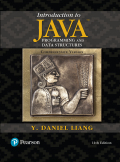
Introduction to Java Programming and Data Structures Comprehensive Version (11th Edition)
11th Edition
ISBN: 9780134700144
Author: Liang
Publisher: PEARSON
expand_more
expand_more
format_list_bulleted
Question
Chapter 26.4, Problem 26.4.1CP
Program Plan Intro
Adelson-Velskii and Landis (AVL) tree:
- Adelson-Velskii and Landis tree is a well-balanced binary tree which is named after scientists G. M. Adelson-Velsky and E. M. Landis.
- In this tree, the difference between the heights of two different sub trees for every node may be 0 or 1.
- The process of insertion and deletion of an element in an AVL tree is same as in binary search tree except the concept of rebalancing the tree again after insertion and deletion.
Expert Solution & Answer
Want to see the full answer?
Check out a sample textbook solution
Students have asked these similar questions
I need help to solve the following case, thank you
hi I would like to get help to resolve the following case
Could you help me to know features of the following concepts:
- defragmenting.
- dynamic disk.
- hardware RAID
Chapter 26 Solutions
Introduction to Java Programming and Data Structures Comprehensive Version (11th Edition)
Ch. 26.2 - Prob. 26.2.1CPCh. 26.2 - Prob. 26.2.2CPCh. 26.2 - Prob. 26.2.3CPCh. 26.3 - Prob. 26.3.1CPCh. 26.3 - Prob. 26.3.2CPCh. 26.3 - Prob. 26.3.3CPCh. 26.4 - Prob. 26.4.1CPCh. 26.4 - Prob. 26.4.2CPCh. 26.4 - Prob. 26.4.3CPCh. 26.4 - Prob. 26.4.4CP
Ch. 26.5 - Use Listing 26.2 as a template to describe the...Ch. 26.6 - Prob. 26.6.1CPCh. 26.6 - Prob. 26.6.2CPCh. 26.6 - Prob. 26.6.3CPCh. 26.6 - Prob. 26.6.4CPCh. 26.7 - Prob. 26.7.1CPCh. 26.7 - Prob. 26.7.2CPCh. 26.7 - Prob. 26.7.3CPCh. 26.7 - Prob. 26.7.4CPCh. 26.8 - Prob. 26.8.1CPCh. 26.8 - Prob. 26.8.2CPCh. 26.8 - Prob. 26.8.3CPCh. 26.9 - Prob. 26.9.1CPCh. 26.9 - Prob. 26.9.2CPCh. 26.9 - Prob. 26.9.3CPCh. 26 - Prob. 26.5PE
Knowledge Booster
Similar questions
- what is a feature in the Windows Server Security Compliance Toolkit, thank you.arrow_forwardYou will write a program that allows the user to keep track of college locations and details about each location. To begin you will create a College python class that keeps track of the csollege's unique id number, name, address, phone number, maximum students, and average tuition cost. Once you have built the College class, you will write a program that stores College objects in a dictionary while using the College's unique id number as the key. The program should display a menu in this order that lets the user: 1) Add a new College 2) Look up a College 4) Delete an existing College 5) Change an existing College's name, address, phone number, maximum guests, and average tuition cost. 6) Exit the programarrow_forwardShow all the workarrow_forward
- Show all the workarrow_forward[5 marks] Give a recursive definition for the language anb2n where n = 1, 2, 3, ... over the alphabet Ó={a, b}. 2) [12 marks] Consider the following languages over the alphabet ={a ,b}, (i) The language of all words that begin and end an a (ii) The language where every a in a word is immediately followed by at least one b. (a) Express each as a Regular Expression (b) Draw an FA for each language (c) For Language (i), draw a TG using at most 3 states (d) For Language (ii), construct a CFG.arrow_forwardQuestion 1 Generate a random sample of standard lognormal data (rlnorm()) for sample size n = 100. Construct histogram estimates of density for this sample using Sturges’ Rule, Scott’s Normal Reference Rule, and the FD Rule. Question 2 Construct a frequency polygon density estimate for the sample in Question 1, using bin width determined by Sturges’ Rule.arrow_forward
- Generate a random sample of standard lognormal data (rlnorm()) for sample size n = 100. Construct histogram estimates of density for this sample using Sturges’ Rule, Scott’s Normal Reference Rule, and the FD Rule.arrow_forwardCan I get help with this case please, thank youarrow_forwardI need help to solve the following, thank youarrow_forward
arrow_back_ios
SEE MORE QUESTIONS
arrow_forward_ios
Recommended textbooks for you
 New Perspectives on HTML5, CSS3, and JavaScriptComputer ScienceISBN:9781305503922Author:Patrick M. CareyPublisher:Cengage Learning
New Perspectives on HTML5, CSS3, and JavaScriptComputer ScienceISBN:9781305503922Author:Patrick M. CareyPublisher:Cengage Learning C++ Programming: From Problem Analysis to Program...Computer ScienceISBN:9781337102087Author:D. S. MalikPublisher:Cengage Learning
C++ Programming: From Problem Analysis to Program...Computer ScienceISBN:9781337102087Author:D. S. MalikPublisher:Cengage Learning Operations Research : Applications and AlgorithmsComputer ScienceISBN:9780534380588Author:Wayne L. WinstonPublisher:Brooks Cole
Operations Research : Applications and AlgorithmsComputer ScienceISBN:9780534380588Author:Wayne L. WinstonPublisher:Brooks Cole- COMPREHENSIVE MICROSOFT OFFICE 365 EXCEComputer ScienceISBN:9780357392676Author:FREUND, StevenPublisher:CENGAGE L


New Perspectives on HTML5, CSS3, and JavaScript
Computer Science
ISBN:9781305503922
Author:Patrick M. Carey
Publisher:Cengage Learning

C++ Programming: From Problem Analysis to Program...
Computer Science
ISBN:9781337102087
Author:D. S. Malik
Publisher:Cengage Learning

Operations Research : Applications and Algorithms
Computer Science
ISBN:9780534380588
Author:Wayne L. Winston
Publisher:Brooks Cole

COMPREHENSIVE MICROSOFT OFFICE 365 EXCE
Computer Science
ISBN:9780357392676
Author:FREUND, Steven
Publisher:CENGAGE L

